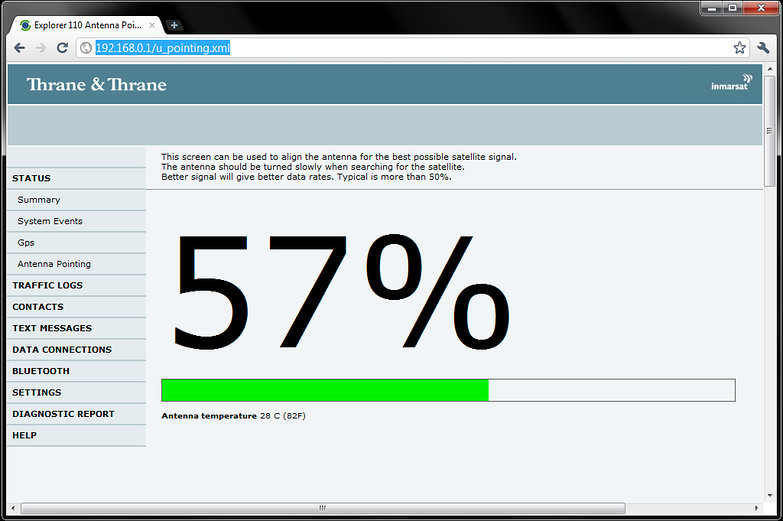Background
Before we left on this adventure, I made a commitment to my clients that their level of support wouldn't change while I was abroad. I bought our BGAN Explorer 110 from Globalcom in October of 2009, just before we went to Tunisia, thinking that their sole cellular provider, Tunisiana didn't offer internet access (they do). Since we planned to be traveling in the country for several months, waiting out winter, it seemed like a necessary decision.
To my relief, I haven't needed to use this expensive solution often. Staying connected has, for the most part, been a non-issue. As it turns out, nearly every country we've spent a significant amount of time in over the last two years has had some form of cellular internet access—even Mongolia. Roads? Not really. Cellular internet access? Yup.
The Hardware
Slightly larger than two DVD cases stacked on top of one another, and weighing in at 2.2 pounds (1kg), our satellite transceiver is a hefty piece of tech to be lugging around in a pannier. Luckily, I've never cared about counting grams! Unlike some poorly constructed electronics which claim to be "expedition ready" (I'm looking at you Powertraveller), our BGAN is built like a tank.
At the time I purchased the staggeringly expensive $2,000 device, it was the smallest and lightest option (read: only choice we physically had space for) on the consumer market. As best I can tell, it still is.
Remembering that this thing communicates with man-made devices in space (actually, geosynchronous low earth orbit, but whatever), the weight and price don't seem totally outlandish.

Service Plans
Just like the device itself, the service plans are extremely expensive. There is a minimum flat monthly fee of $39 just to access the network, and every megabyte transferred costs a whopping $6.50. With a max connection speed of 368kbps, it would be possible to churn through hundreds of dollars per minute with this thing. Yikes.
Prepaid SIMs are also an option, but I had no idea how much I would be using it, so I stuck with the service plan offerings. Just $9,000 per GB of transfer! *gulp*
Providers
Service providers for access to the Imarsat network purchase "units" in bulk directly from the company for resale to customers. Pricing is almost exactly the same across all resellers. I went with GlobalCom because they responded quickly to my emails, answered the phone when I called, seemed excited about our trip, and gave us a huge discount on the hardware (which is normally something like $2,800).
GlobalCom's staff was also very understanding about the fact that we were on the road and needed everything sent to us within a specific time-frame. I would highly recommend them to anyone (even if they have a super annoying avatar on their website that walks on to your screen to talk to you).
Actual Usage
Needless to say, browsing the web for pleasure on a connection like this is reserved for the impossibly rich. Typically, the process of pushing out updates to my software and responding to email chews through 1-2mb of transfer. I connect just long enough to download email, disconnect to craft replies and implement any requests (I have a self contained development environment on my laptop for all of my client's software, allowing me to program offline), then connect again to send out the updates.
Where I Needed It
I used our transceiver during wild camps in Serbia and Macedonia because our "worldwide" cellular solution, Mobility Pass (which wasn't much cheaper) didn't work properly, and we never investigated local options. I also used it during several remote wild-camps in Romania and Russia. Our heaviest usage has been in Mongolia and Laos—though both have cellular options, they are limited in coverage.

How to Connect
The BGAN Explorer 110 provides an internet connection via ethernet or wirelessly, using bluetooth. I opted for the ethernet cable to save on battery life. There is a convoluted software package included for connecting to the network, but the device also has a small web service running on it, which allows it to be controlled via any browser.

The browser shown above is Google Chrome. If you are reading this using Internet Explorer, please go try it. Not only is much faster, web developers the world over will thank you.
A clear view of the sky is required—trees and other objects will greatly diminish the signal strength. Even a hand in front of the receiver can sever the connection. To actually establish a link with the satellites above, the transceiver's built-in GPS must first have a location fix. Without it, the device cannot operate effectively, as there is a variable time delay in the transmissions depending on the distance to the satellites.
Once the device knows where it is, connecting is accomplished by pointing the receiver at the sky and slowly rotating until it starts beeping. This is the really cool part: slow quiet beeps increase in frequency and pitch as the reciever is aimed. The tones are really obnoxious, but using them makes me feel like a spy, so I never turned them off!

Conclusion
Hugely expensive upfront and continuing costs will prohibit the effectiveness for most, but if a guaranteed internet connection is required anywhere in the world, and price/weight aren't an issue, this is a fantastic device. Never having to worry about connectivity for work is a huge peace of mind, but even so, I can't help but think I could have gotten away without it.
Resale value seems to hold fairly well for these, but I am going to keep ours, as we may yet travel someplace off the beaten path where there are no other options (on some other adventure, not this one!).